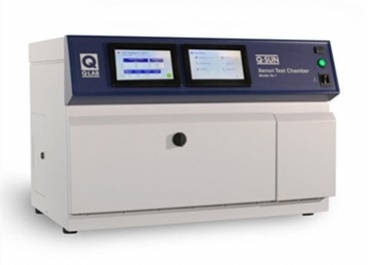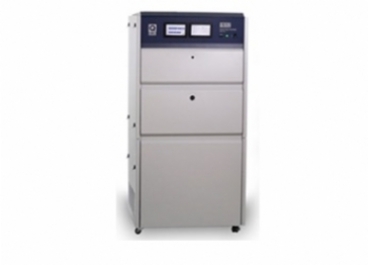咨询热线
18566398802GMW 14162-2011测试标准
-> GMW 14162-2011标准介绍
-> 下载GMW 14162-2011PDF
-> 符合GMW 14162-2011的仪器
GMW 14162-2011标准介绍
1 Scope
Note: Nothing in this standard supercedesapplicable laws and regulations.
Note: In the event of conflict between the Englishand domestic language, the English language shalltake precedence.
1.1 Purpose.This test method shall be used todetermine the effects of weathering using a xenon-arc lamp source (artificial sunlight) to simulateextreme environmental canditions encounteredinside a vehicle due to sunlight, heat and humidity.
This method shall be used to evaluate thecolorfastness, as well as being the artificialweathering method to evaluate degradation.
This method describes four possible exposurecycles:
Method A. Light and Dark Exposure Cycle(100 ℃, 420 nm). The cycle alternates betweenlight and dark periods. This cycle is based onIS0 105-B06 exposure condition Number Three.
Method B.Light Only Exposure Cycle (100 ℃, 300 to 400 nm). This cycle is based onISO 105-B06 exposure condition Number Three.
Method C. Light Only Exposure Cycle (115 ℃, 300 to 400 nm). This cycle is based onIS0 105-B06 exposure condition Number One.
Method D. Light and Dark Exposure (89 ℃,340 nm). The cycle alternates between light anddark periods. This cycle is based on IS0 105-B06exposure condition Number Five(SAE J1885/SAE J2412 equivalent withSAE J2413 as the companion document).
1.2Foreword.This test method was developed bythe Global Textile Team to create a commonmethod for evaluating colorfastness to artificialweathering.
1.3 Applicability. Not applicable.
2 References
Note: Only the latest approved standards areapplicable unless otherwise specified.
2.1External Standards/Specifications.
ISO 105-A02
ISO 105-B06
ISO 4892-1
SAE J1885
SAE J2412
SAE J2413
SAE 12414
2.2 GM Standards/Specifications.
GMW6992
2.3Additional References.None.
3 Resources
3.1 Facilities. Not applicable.
3.2Equipment.
3.2.1 Method A. Test equipment. according toISO 105-B06. with the following machine setupshall be used:
3.2.1.1Filters.
Inner filter: Type S Borosilicate
Outer filter: Soda Lime
Appendix A defines the Spectral Power distributionfor Type "S" Borosillicate/Soda Lime filtercombination for Method A.
3.2.1.2 Temperature Sensor. Black StandardTemperature (BST).
3.2.1.3Chamber (Dry Bulb) Temperature.Active.
3.2.1.4Rack Panel.Temperature.Active.
3.2.1.5Radiation.Controlled at 420 nm.
3.2 2Method B. Test equipment according toISO 105-B06 with exposure apparatus B or C shallbe used.
3.2.3 Method C. Test equipment according toISO 105-B06 with exposure apparatus B with4IR+3WG or 10 WG filter system shall be used.
3.2.4 Method D. Test equipment according toISO 105-B06 for exposure condition Number Fiveor SAE J2414/SAE J2413.
3.2.5 White-Standard Thermometer. The WhiteStandard thermometer is in accordance with theBlack Standard thermometer of ISO 105-B06.However,the metal plate is provided with a whitecover according to ISO 4892-1 .
3.3 Test Vehicle/Test Piece. Test materialaccording to ISO 105-B06 shall be used.
3.4 Test Time. The timing will be set based on thematerial specification requirement.
3.5 Test Required Information. Not applicable.
3.6 Personnel/Skills. Not applicable.
4 Procedure
Test specimens are exposed in a xenon-arcweathering device to artificial weatheringconditions which simulate extreme environmentalconditions encountered inside a vehicle due tosunlight, heat, and/or humidity. Test specimens arethen evaluated for colorfastness (fade) or othermodes of degradation.
4.1 Preparation. Test samples shall be preparedaccording to ISO 105-B06.
A conditioning to GMW3221 StandardConditioning of Organic Materials is notrequired.
4.2 Conditions.
4.2.1 Environmental Conditions. See 4.3.1
4 2.2 Test Conditions. Deviations from therequirements of this standard shall have beenagreed upon. Such requirements Shall be specifiedon component drawings, test certificates, reports,etc.
4.3.1 Exposure Conditions.
4.3.1.1Method A. Exposure conditions accordingto ISO 105-B06 Condition Three, but withparameters according to Table 1. Exposure beginsin the Dark Period. The Dark and Light Periods arealternated until the required exposure level ofkilojoules per square meter (kJ/m2) is met. Thetiming for the Light Period only is calculated fromthe required radiant exposure as:
t=Q/(E X 3.6)
Where:
Q is the radiant exposure expressed inkilojoules per square meter
Eis the irradiance expressed in watts per square meter (or joules per square metersecond)
tis the time expressed in hours
3.6 is the conversion factor expressed inkiloseconds per hour
Appendix B identifies timing for typical requiredirradiation values.
Table 1: Exposure Conditions for Method A

Note 1:Method A consists of five alternating Dark Periods 1 h per each period) and five light Periods (3.8 h per each period) in a 24 hduration with the test beginning in the Dark Period.
4.3.1.2 Method B. Exposure conditions shall beaccording to ISO 105-B06 Condition Three but withhumidity of O to 20% relative humidity (RH).
In addition to the Black Standard Temperature of+100 ℃, a white Standard Temperature of +76±1 ℃ is observed for information only.
The timing (number of cycles) for the wide bandexposure is calculated per the equation in 4.3.1.1.
Appendix B displays timing for typical requiredradiant exposure values.
4.3.1.3 Method C. Exposure conditions shall beaccording to ISO 105-B06 Condition One but withhumidity of O t0 20% RH.
In addition to the Black Standard Temperature of+115 ℃, a White Standard Temperature of 75±1 ℃ is observed for information only.
The timing (number of cycles) for the wide bandexposure is calculated per the equation in 4.3.1.1.
Appendix B displays timing for typical requiredradiant exposure values.
4.3.1.4Method D. Exposure conditions shall beaccording to ISO 105-B06 Condition Five orSAE J2412/SAE J2413.
4.3.2 Exposure. Exposure shall be according toISO 105-B06. The exposure shall be continueduntil the required radiant exposure value asSpecified in the relevant material specification hasbeen reached. The time until the required radiantexposure value has been reached is noted.
5 Data
5.1 Calculations. Visual assessment forcolorfastness shall be made by a person with atrained eye. Compare the test specimen to acontrol sample and the gray scale (refer toISO 105-A02) under standard lighting defined inGMW6992. All comparisons shall be made withlike sized evaluation areas.
Perform color and gloss measurements, ifapplicable.
Calculate the differences between the unexposedcontrol sample of the start of test values of theunexposed sample and the exposed testspecimen.
Degradation evaluations to be completed andreported according to the methods defined in therelevant material specification.
5.2 Interpretation of Results.
5.2.1 Report the color change rating from visualassessment at required exposure level. Note anyappearance or degradation changes seen that arenot included on the color change rating scale.
5.2.2If required, report the color machinemeasurements for color change using theCIELAB D65/10° measurements for DE*, DL*, DC*, DH*, Da*, Db* at each required exposurelevel.
5.2.3 If required, for information only, provideStandard Reference Manual (SRM) data for thedays the test specimen was being tested.
5.2.4 Report all test parameters according tomaterial specification.
5.3Test Documentation. The results of the testswill be recorded in the Test Report.
6 Safety
This standard may involve hazardous materials,operations, and equipment. This standard does notpropose to address all the safety problemsassociated with its use. It is the responsibility of theuser of this standard to establish appropriate safetyand health practices and determine theapplicability of regulatory limitations prior to use.
7 Notes
7.1 Glossary. Not applicable.
7 2 Acronyms, Abbreviations, and Symbols.
BST Black Standard Temperature
RH Relative Humidity
SPD Spectral Power Distribution
SRM Standard Reference Manual
8 Coding System
This standard shall be referenced in otherdocuments, drawings, etc., as follows:
Test to GMW14162/A/640 kJ/m2/Rating 4 minimum
Where:
GMW= Validation area (GMWorldwide)
14162 = Sequential number
A = Method
640 kJ/m2 = Required radiant exposurevalue
Rating 4 minimum=Requiredminimalgrayscale rating to ISO 105-A02.
9 Release and Revisions
This standard was originated in June 2005. It wasfirst approved by the Global Textile Team inOctober 2006. It was first published inOctober 2006.

Appendix A

Figure A1: Spectral Power Distribution (SPD) for Filter Combination of Method A
Appendix B


更多GMW 14162-2011解读
请加微信咨询: 13202947058
符合 GMW 14162-2011 标准试验箱
-
氙灯老化箱
Q-SUN Xe-1-B是一款适合小型实验室的氙灯老化箱,其命名规程B指的是改型号的产品具有背部喷淋功能,这意味着在SAE部分标准的测试中尤其有用。
马上询价 -
氙灯老化试验箱
Q-SUN Xe-3-HSE氙灯老化试验箱具有全光谱光照功能、湿度控制以及喷淋功能,其命名规则为湿度控制(H)、喷淋(S)。
马上询价 -
氙灯老化试验机
Q-SUN Xe-3-HCE是一款具有全光谱光照模拟、湿度控制以及制冷功能的氙灯老化试验机,其命名规则为湿度控制(H)、制冷功能(C)。
马上询价 -
氙灯耐气候试验箱
Q-SUN Xe-3-HDSE氙灯耐气候试验箱具有湿度控制、以及双喷淋功能,其命名规则为湿度(H)、双喷淋(D)、喷淋(S)。
马上询价 -
氙灯老化试验箱
Q-SUN Xe-3氙灯老化试验箱能再现全光谱太阳光和雨水造成的损害。在几天或几周之内,Q-SUN试验箱就能够再现数月或数年户外老化造成的损害
马上询价 -
氙灯耐候试验箱
Q-SUN Xe-3-HSCE氙灯耐候试验箱同时具有湿度控制、喷淋以及制冷功能,其命名规则为湿度(H)、喷淋(S)、制冷(C)。
马上询价 -
氙灯加速老化箱
Q-SUN Xe-3-HE氙灯加速老化箱是一款经济的氙灯加速老化箱,具备有湿度控制功能,但是该型号的产品不具备水喷淋功能。
马上询价

